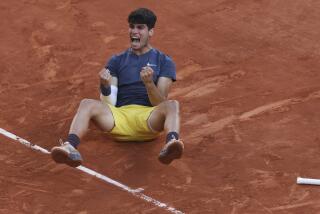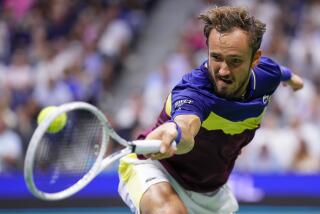Bruguera Does Reputable Job
- Share via
PARIS — Unassuming, reserved and vanished from the tennis map for most of last year, Sergi Bruguera of Spain is an unlikely candidate for hero status. But here at the French Open, the former champion is being toasted--with great relief--as the only seeded player to reach the men’s semifinals.
After 10 days of unpredictable tennis at Roland Garros, 15 seeded men have fallen. Tournament officials were facing the possibility that, for the first time in any Grand Slam tournament, there would be no seeded players among the semifinalists. In that context, Bruguera’s victory Wednesday was cause for celebration.
He’s seeded only because Thomas Enqvist of Sweden withdrew shortly before the tournament, allowing Bruguera to grab the last seeded position--No. 16. And he’s barely in the semifinals, having needed all of his experience and wit to stave off Hicham Arazi of Morocco in Wednesday’s quarterfinal.
Bruguera defeated Arazi, 4-6, 6-3, 6-2, 6-2. He’ll play Patrick Rafter of Australia in the semifinals Friday. Rafter defeated Galo Blanco of Spain, 6-3, 7-6 (7-3), 6-3. In the other semifinal, Gustavo Kuerten of Brazil will face Filip Dewulf of Belgium.
With Bruguera ranked No. 19, Rafter No. 25, Kuerten No. 66 and Dewulf No. 122, the average ranking of the semifinalists is 58, a situation that tennis purists have found appalling for a Grand Slam tournament. Others note the increasing depth in the men’s game and relish the fresh faces.
“Who would have ever thought these three players would be in the semifinals?” Rafter said. “The chances are billion to one. But it’s happened, so that’s tennis, I guess.”
Bruguera, 26, won here in 1993 and 1994 and for a time was the world’s preeminent clay-court player. He was in the vanguard of the Spanish resurgence now gripping the sport. Bruguera is one of 18 Spaniards in the draw, six of them seeded.
His ranking plummeted from a high of No. 4 to No. 81 last year, when he suffered torn ligaments in his right ankle. This season has been better. Bruguera beat Michael Chang and Pete Sampras to get to the final of the Lipton in March. His return to form has dovetailed nicely with the tournament’s need for him to do well.
Bruguera needed to play at his best against Arazi, who was born in Morocco and raised in France. Arazi began well, but Bruguera began to move him around after the second set and, on a warm day, Arazi began to wilt. That led to his 75 unforced errors.
Rafter had less resistance from Blanco, who had won only one match on the men’s tour (1-6) before the French Open. Blanco’s comfort level on clay did little to offset Rafter’s powerful, attacking game.
Rafter was raised, like most Australian tennis players, on hard courts. But like most Queenslanders, he also has played on antbed, which plays something like a slippery version of clay.
Antbed courts are fashioned by knocking down tall towers of ant hills, crushing them, treating them with water, and marking the court with lines. It’s cheap and it’s available.
Because of his background on fast courts, Rafter has developed a serve-and-volley game that’s not usually or easily translated to clay courts. The game’s best serve-and-volley player, Sampras, went years fiddling with his game to adjust to clay. Last year Sampras jettisoned that approach and played his natural style. He reached the semifinals, his best showing ever.
Rafter has wisely played to his strengths here. That decision has been aided by predominantly warm weather that has kept the courts fast. Even occasional rain has not been enough to slow play markedly.
Against Blanco, Rafter wanted to be aggressive when he served, keep the ball in play when returning and wait for the short ball.
“That pretty well was the game plan,” he said. “I had to change it slightly [in the fourth round] against Mark Woodforde because he was returning my second serve so well. I had to move back or change up my second serve a little bit. It’s important to evaluate as you go out. The main strength for me is to serve and volley and knock the ball around until I get into the net.”
More to Read
Go beyond the scoreboard
Get the latest on L.A.'s teams in the daily Sports Report newsletter.
You may occasionally receive promotional content from the Los Angeles Times.











